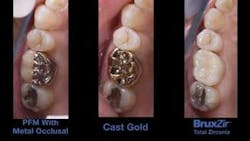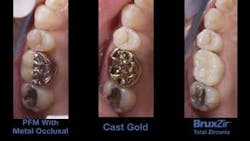A new concept in tooth–colored restorations
by Michael Di Tolla, DDS, FAGD
For more on this topic, go to www.dentaleconomics.com and search using the following key words: cast gold, tooth–colored restorations, metal occlusals, zirconia, Dr. Michael DiTolla.
For a long time, I have had a single wish in dentistry: a cast gold material that came in VITA shades A2 and A3. Having attended dental school more than 20 years ago, I was taught that cast gold was the best restorative material in dentistry. We were also taught that the gold foil was perhaps the best utilization of this material.
That said, every crown I did in dental school was a PFM; I did not do a cast gold crown until the state board exam because this is what California required. I could not even convince dental school patients to opt for gold.
Furthermore, we never did a gold foil on a typodont, but instructors did show us a film of a dentist doing one. In retrospect, I guess this was done so we could discuss the procedure with older dentists we might bump into at conventions.
When I graduated, I practiced with my father and I saw cast gold everywhere! He graduated in 1964 when the PFM was still more rumor than reality. As I saw more of his patients through the years, I began to notice that cast gold seemed to last a long time, even though some patients asked me if it could be replaced because they could see the gold when they smiled.
“You want me to replace the best material in dentistry with a piece of plastic or glass?” I said. I thought, if only we had a cast gold that wasn’t visible from 30 yards away.
I also had a few patients get upset at metal occlusals. Typically, this occurred on a lower molar with a short clinical crown. This leads to a tendency to do minimal reduction on the occlusal surface and results in the lab asking to do a metal occlusal.
At this point, the crown ceases to be a PFM to the patient since the only porcelain on this crown is covered by one’s cheek. Everything the patient can see is highly reflective metal.
Enter BruxZir. A full–contour zirconia, the entire crown has no porcelain on it. This allows you to introduce BruxZir in clinical situations in which you would usually need to use cast gold or a metal occlusal. While you won’t confuse BruxZir with an all–ceramic crown anytime soon, you will benefit from a high–strength, all–zirconia restoration. That’s why BruxZir is said to be “more brawn than beauty.” The next time you want cast gold and the patient refuses, I suggest you give BruxZir a try.
Take a look at the three restorative options below for a minimally reduced crown, and see which one you think patients would choose.
To have Dr. Michael DiTolla speak at your next study group or dental society, contact him at [email protected]. For more information, visit www.drditolla.com or www.glidewelldental.com.

